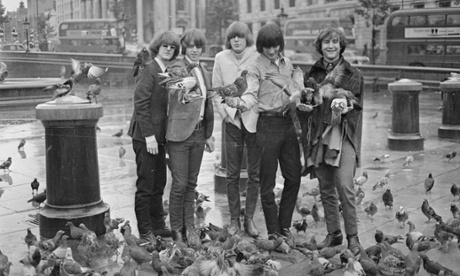The Byrds: how we made Eight Miles High
Roger McGuinn, singer-songwriter: ‘When some DJs decided it was about drugs, it got banned – and that was the end of us’

Roger McGuinn, singer-songwriter/lead guitar
Eight Miles High has been called the first psychedelic record. It’s true we’d been experimenting with LSD, and the title does contain the word “high”, so if people want to say that, that’s great. But Eight Miles High actually came about as a tribute to John Coltrane. It was our attempt to play jazz.We were on a tour of America, and someone played us the Coltrane albums Africa/Brass and Impressions. I had just picked up a cassette recorder – it was such a new thing, you couldn’t buy any tapes to play in it. But I had some blank tapes so recorded the Coltrane albums, along with some Ravi Shankar, and took them on tour. It was the only music we had, for the whole time on the bus. By the end of the tour, Coltrane and Shankar were ingrained.
There was one Coltrane track called India, where he was trying to emulate sitar music with his saxophone. It had a recurring phrase, dee da da da, which I picked up on my Rickenbacker guitar and played some jazzy stuff around it. I was in love with his saxophone playing: all those funny little notes and fast stuff at the bottom of the range.
At the same time, Gene Clark [rhythm guitar] had some chords and a vague melody, which went into the more regular structure of Eight Miles High. In later years, Gene started to fantasise that he wrote the whole song. That wasn’t the case: it was a collaborative effort between myself, Gene and David Crosby [vocals, rhythm guitar]. The previous year, 1965, we’d been on a trip to England. It was our first time on a plane, and I had the idea of writing a song about it. Gene asked: “How high do you think that plane was flying?” I thought about seven miles, but the Beatles had a song called Eight Days a Week, so we changed it to Eight Miles High because we thought that would be cooler.
When the song came out, some DJs did the sums and realised that, since commercial airliners only flew at six miles, we must have been talking about a different kind of high. And all the stations stopped playing it. We put out a statement refuting those claims, but it was the end of our commercial success. The Byrds were damaged goods.
Gene left the band the month Eight Miles High was released. He was afraid of flying. We’d get on a plane, and he’d be in a cold sweat, standing up in the aisle, saying: “I can’t stay on this plane, man. I gotta get off.” I remember saying: “You can’t be a Byrd if you can’t fly.”
David Crosby, singer-songwriter/rhythm guitar
Of course Eight Miles High was a drug song. It does refer to the altitude of that flight, but it was a deliberate double entendre. I thought it was Gene’s idea to write a song about our trip to London – he was a wonderful, talented man. But if Roger says it was his idea, maybe it was.We all wrote it together in a Winnebago motorhome, hurriedly swapping lyrics and ideas for the chord progression. The line “And when you touch down, you’ll find it stranger than known” is about the disorientation we felt. We were 21, had never been out of the States, and everything was alien. We struggled to understand people – there must have been 25 different British accents.
“Nowhere is there warmth to be found” refers to our treatment by the British press. A terrible promoter billed us as “America’s answer to the Beatles”. Of course, the press jumped on us for that, but the Beatles knew we’d never say a thing like that because we worshipped them. And they were extremely welcoming, driving us home from gigs, taking us to dinner and parties.
The reference to black limousines means the Austin Princess, a bulbous British car that record companies used a lot because it was cheaper than a Bentley. And the line about a “rain grey town” was mine. “Round the squares huddled in storms” refers to bad weather in London and people clustered in doorways to avoid the rain coming down in sheets.
We knew Eight Miles High was a special song and wanted to record it properly. We were signed to Columbia, whose studios were union-controlled with regular breaks and everything. We thought they were dicks. Meanwhile, Jefferson Airplane were recording down the street at RCA with Al Schmitt, one of the greatest recording engineers in history. So I said to the band: “What if we sneak out and cut it with real guys in a real studio?” So we snuck out and cut a version. When Columbia found out, they threatened to cancel our contract, sue us, everything. Battle raged until eventually our management caved in and we cut another version for Columbia, which became a classic. I still think the first version is better, though.
No comments:
Post a Comment